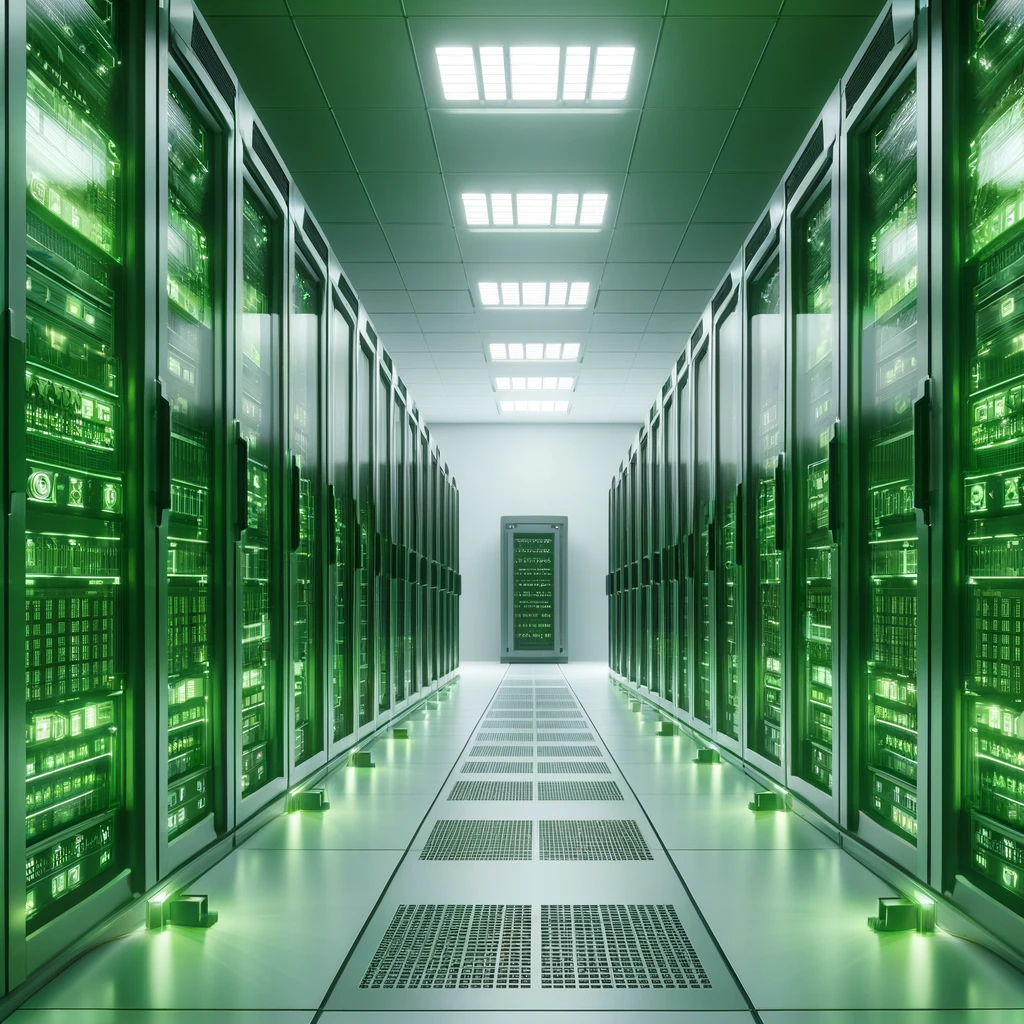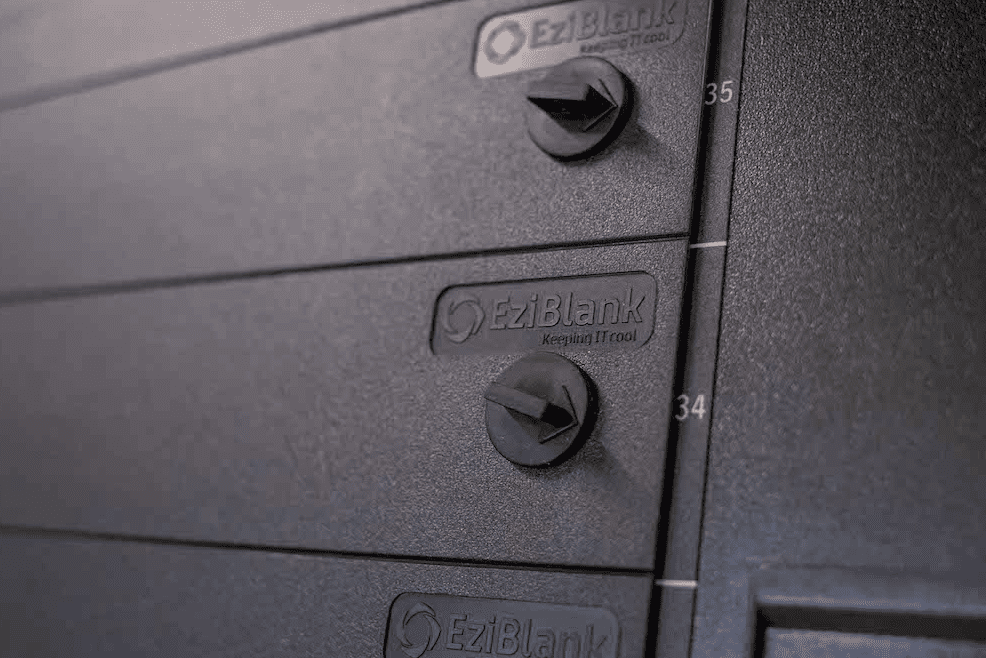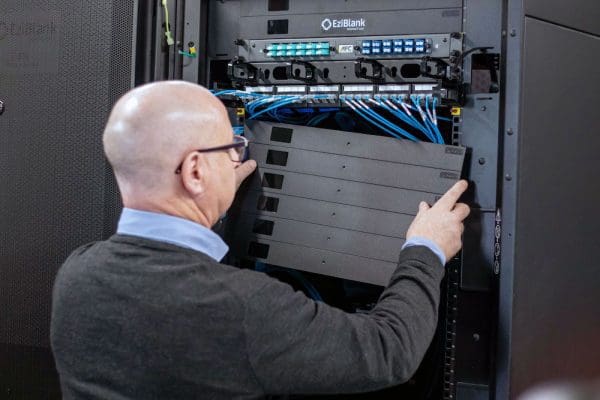Blanking panels, often overlooked, play a pivotal role in the efficient operation of data centers. These simple yet crucial components are essentially flat pieces, either metallic or plastic, used to fill unused rack space in server racks. Their primary function is to create a barrier between the cold air intake and hot air exhaust, thereby optimizing the cooling systems within the data center.
What are Blanking Panels?
- Material and Configuration: Blanking panels are available in various sizes ranging from 1U to 6U and can include features like brush strips for enhanced cable management.
- Purpose and Functionality: The core purpose of these panels is to prevent the mixing of hot and cold air, which is vital for maintaining an efficient cooling environment in data centers. By filling gaps in server racks, they minimize the risk of hot air recirculating back into the cold zone.
Benefits of Using Blanking Panels
- Improved Airflow Management: Blanking panels streamline airflow, directing cold air to where it is most needed and keeping hot air from re-entering the cooling loop.
- Enhanced Energy Efficiency: By maintaining proper separation of hot and cold air, these panels reduce the workload on cooling systems, thereby saving energy and reducing operational costs.
- Protection of Sensitive Equipment: Consistent temperatures and reduced risk of overheating help protect critical server components from thermal damage.
- Cost-Effective Solution: Particularly plastic blanking panels offer a budget-friendly option without compromising on functionality. They are lightweight, easy to install, and provide a quick fix to potential airflow issues.
Types of Blanking Panels
- Plastic Panels: Known for their affordability and ease of installation, plastic blanking panels are a go-to for immediate airflow correction. However, they might need more frequent replacements due to less durability.
- Metal Panels: These are more robust, provide better security, and have a longer lifespan. Although they come at a higher initial cost, their durability makes them a worthwhile investment for long-term energy efficiency.
Installation and Usage
- Ease of Installation: Some blanking panels can be snapped into place without tools, while others might require screws for a more secure fit.
- Universal Application: It’s advisable to use blanking panels on all empty spaces, not just the larger gaps, to ensure comprehensive airflow management and energy efficiency.
Strategic Implementation
To maximize benefits, it’s essential to:
- Cover All Gaps: Utilize blanking panels in all open rack spaces, regardless of size, to maintain optimal airflow dynamics.
- Regular Assessment: Continually assess the setup to adapt to new configurations or equipment upgrades that might alter airflow needs.
By integrating blanking panels effectively, data centers can significantly enhance their cooling efficiency, leading to notable energy savings and a more stable operating environment for sensitive IT equipment.
Understanding Energy Consumption in Data Centers
Data centers are critical infrastructures that support the vast data requirements of modern society, from cloud computing to personal data storage. However, they are also significant energy consumers. Here, we delve into the factors contributing to high energy usage in data centers and discuss the importance of energy efficiency.
Key Drivers of Energy Consumption
- IT Equipment and Infrastructure: At the heart of energy consumption in data centers are the IT components themselves, including servers, storage systems, network infrastructure, and connectivity systems. These devices not only consume power but also generate heat, which needs to be managed to prevent equipment failure and ensure efficiency.
- Cooling Systems: To remove the heat generated by IT equipment, robust cooling systems are essential. These systems themselves consume a substantial amount of energy. Managing the cooling requirements without compromising on system performance is a continuous challenge for data center operators.
- Power Distribution: Energy used in data centers must undergo several stages of distribution before it reaches the IT systems. Each stage typically introduces energy losses, primarily in the form of heat, necessitating further cooling and thus creating a cycle of increased energy use.
The Impact of Energy Consumption
- Operational Costs: High energy consumption directly translates to higher operational costs. Data centers require continuous power for both running the IT equipment and cooling systems, contributing to significant ongoing expenses.
- Environmental Impact: Data centers are estimated to consume up to 3% of global electricity and could reach 4% by 2030. This substantial energy use has a direct impact on carbon emissions, contributing to global warming.
- Regulatory and Market Pressure: Increasing awareness of environmental issues has led to greater regulatory scrutiny on the energy and water use in data centers. Companies are also facing market pressure from consumers and stakeholders to improve their environmental footprint.
Opportunities for Optimization
- Advanced Cooling Techniques: Implementing cutting-edge cooling technologies and optimizing airflow with devices like blanking panels can significantly reduce the energy needed for cooling.
- Energy-Efficient Equipment: Upgrading to more energy-efficient IT equipment can reduce overall energy consumption. Techniques like virtualization and the use of ARM-based processors help in optimizing the energy usage without compromising on performance.
- Renewable Energy Sources: Investing in renewable energy sources, such as onsite solar photovoltaic (PV) arrays or entering into power purchase agreements for renewable energy, can offset the environmental impact of data center operations.
- Heat Recovery Systems: Utilizing waste heat through technologies like absorption chillers can help in reducing the cooling requirements and improving overall energy efficiency.
Understanding and managing energy consumption in data centers is crucial not only for reducing operational costs but also for minimizing environmental impact. As technology advances, data centers have the opportunity to adopt more sustainable practices that align with global energy efficiency goals.
How Blanking Panels Improve Energy Efficiency
Role of Blanking Panels in Enhancing Cooling Efficiency
Blanking panels are not just simple accessories in data centers; they are critical tools in managing and improving energy efficiency. By effectively preventing the mixing of hot and cold air, these panels ensure that cooling systems do not have to work overtime, thereby reducing energy consumption significantly. Here’s how blanking panels contribute to more efficient data center operations:
- Prevention of Hot and Cold Air Mixing: When installed in unused rack spaces, blanking panels create a physical barrier that prevents hot exhaust air from recirculating to the front of the rack where cool air is drawn in. This separation helps maintain the desired temperatures in the cold aisle without interference from the hot aisle.
- Elimination of Airflow Bypass: By filling gaps in server racks, blanking panels prevent cooled air from bypassing the equipment and escaping through unoccupied spaces. This targeted airflow ensures that cool air is used efficiently to cool active equipment rather than being wasted.
- Reduction of Hot Spots: Hot spots are areas within a data center that have higher temperatures due to inadequate cooling. Blanking panels help eliminate these hot spots by directing the airflow precisely where it is needed, ensuring a uniform temperature across the data center.
- Enhanced Cooling System Efficiency: With better airflow management provided by blanking panels, the cooling systems can operate at optimal efficiency. This not only extends the life of the cooling equipment but also reduces the energy required for cooling operations.
- Cost Savings from Efficient Energy Use: The strategic placement of blanking panels in data centers can lead to substantial cost savings. By improving the effectiveness of cooling systems, data centers can reduce their power consumption, which directly translates into lower energy bills.
- Supporting Sustainable Practices: Efficient energy use is a step towards more sustainable operations in data centers. By reducing the power consumption required for cooling, blanking panels help in lowering the overall carbon footprint of data center operations.
Quantifiable Benefits of Blanking Panels
The impact of installing blanking panels is not just theoretical but can be quantified in terms of energy savings and cost reduction. For instance, large data centers have reported annual savings of up to $360,000 simply by implementing blanking panels effectively. Additionally, the energy savings per 12-inch panel installed can range between 1-2%, showcasing the significant role these panels play in energy conservation.
By understanding and implementing these energy-efficient practices, data centers can achieve a more sustainable operation model, contributing to both economic and environmental benefits.
Comparison with Other Energy Saving Techniques
Blanking panels are a vital tool for enhancing energy efficiency in data centers, but they are just one of many strategies employed to reduce energy consumption and costs. Here’s how blanking panels compare to other energy-saving techniques:
High Efficiency Power Distribution Units (PDUs)
- Efficiency Levels: High-efficiency PDUs are reported to be 2 to 3 percent more efficient than conventional units, reducing energy losses significantly.
- Cost Implications: While they offer reduced energy losses, the initial investment and maintenance for high-efficiency PDUs can be higher than standard units.
Energy-Efficient Uninterruptible Power Supplies (UPS)
- Energy Savings: These systems minimize electrical losses and may feature an eco-mode that reduces energy costs by as much as 2 percent.
- Operational Impact: They provide critical backup power with less energy waste, though the cost and complexity of installation can be considerable.
Advanced Cooling Techniques
- Hot/Cold Aisle Layouts: Implementing a hot aisle/cold aisle layout can reduce fan energy use by 20% to 25%.
- Containment Systems: Using containment systems, such as curtains or Plexiglas panels, can prevent cold air from mixing with hot air, reducing cooling costs by 5% to 10%.
Virtualization and Processor Efficiency
- Server Efficiency: Virtualization allows multiple virtual servers to run on a single physical server, potentially reducing energy costs by consolidating resources.
- Processor Choices: The use of ARM-based processors helps optimize energy consumption, offering a more energy-efficient alternative to traditional processors.
Utilization of Free Cooling
- Cost Efficiency: Free cooling uses external air to cool data centers, significantly reducing the reliance on mechanical cooling systems.
- Location Dependency: The effectiveness of free cooling largely depends on the climate, as it requires cooler external temperatures to be efficient.
Smart Technology Integration
- Machine Learning: Applying machine learning to optimize cooling system setpoints can provide marginal energy gains by adapting to variable outside conditions.
- Sensor and Controls: Using sensors and controls to match cooling capacity with IT loads can enhance overall energy efficiency.
Economic and Environmental Impact
- Cost Savings: Techniques like server consolidation and using energy-efficient technologies can lead to substantial savings on energy bills.
- Sustainability: Many of these technologies contribute to a lower carbon footprint by optimizing energy use and reducing waste.
By comparing blanking panels with these varied techniques, it’s evident that while blanking panels play a crucial role in improving energy efficiency, a holistic approach encompassing a combination of these strategies can provide the best outcomes in terms of energy savings, operational efficiency, and environmental impact in data centers.
Future Trends in Energy Efficiency and Blanking Panels
Embracing Renewable Energy and Advanced Cooling Solutions
As we look to the future, the integration of renewable energy sources such as solar and wind is becoming increasingly significant in data center operations. The shift towards these sustainable solutions not only supports environmental goals but also enhances the overall energy efficiency of these facilities. Furthermore, the use of natural cooling resources like seawater is gaining traction, offering a promising avenue for reducing reliance on traditional, energy-intensive cooling methods.
Legislative and Policy Shifts Impacting Data Center Operations
The landscape of data center energy consumption is also being shaped by a variety of statutory and voluntary measures aimed at improving sustainability. Engaging with industry stakeholders to develop effective metrics and policies is crucial. These include mandatory disclosure of energy performance data, establishing minimum energy performance standards for servers, and setting building code requirements that focus on HVAC efficiency. Such initiatives are essential for fostering a more sustainable approach to data center design and operation.
Innovations in Data Center Design and Management
The trend towards prefabricated, modular data center designs is on the rise, with 99% of enterprise data center operators considering this approach for future strategies. This shift is driven by the need for faster deployment and the efficiencies gained from standardization. Additionally, the increasing acceptance of liquid-cooled server technologies and higher-density racks calls for innovative thermal management strategies, such as direct-to-chip cooling, which are becoming integral components of modern data center infrastructure.
The Role of Emerging Technologies in Shaping Data Center Efficiency
Looking ahead, the implementation of cutting-edge technologies such as hydrogen fuel cells for backup power and the integration of advanced cooling systems are set to redefine how data centers operate. These technologies not only promise enhanced efficiency but also the potential for continuous operation, significantly reducing the environmental impact of data center activities. Moreover, the rise of the metaverse and the deployment of 5G technology necessitate the development of more robust and energy-efficient computing solutions at the edge of the network.
Global Trends in Energy Performance
The global landscape of data center energy efficiency is witnessing a shift with newer facilities adopting more efficient cooling designs and optimized controls. These centers, especially those larger than 1 MW and less than 15 years old, are achieving lower Power Usage Effectiveness (PUE) ratings, reflecting advancements in both IT equipment efficiency and facility management. This global trend underscores the critical role of innovative data center design in achieving energy efficiency at scale.
By staying abreast of these trends and continuously evolving with technological advancements, data centers can significantly enhance their energy efficiency. This not only leads to reduced operational costs but also supports broader sustainability goals, making it essential for data centers to integrate these future trends into their strategic planning.
Conclusion
Throughout the discussion on the pivotal role of blanking panels in enhancing energy efficiency within data centers, we have explored their function in preventing the mixing of hot and cold air, the subsequent benefits on cooling systems, and the detailed comparison with other energy-saving measures. These panels not only streamline the airflow, reducing hot spots and optimizing cooling systems, but also significantly mitigate the energy consumption of these critical infrastructures. By integrating blanking panels, data centers can achieve a fine balance between operational efficiency and environmental sustainability, highlighting the tangible benefits in terms of reduced energy bills and lowered carbon footprint.
As the landscape of data center design and operation continues to evolve, driven by technological advancements and a heightened focus on sustainability, the strategic implementation of blanking panels emerges as a cornerstone of energy-efficient practices. The future trends in data center energy efficiency underscore the importance of adopting innovative solutions like Eziblank’s blanking panels, which are designed to address the pressing need for reduced energy consumption. We encourage data center operators to evaluate their current setups and consider the integration of these efficient solutions, leading the way towards more sustainable and cost-effective operations in the face of a data-driven future.



